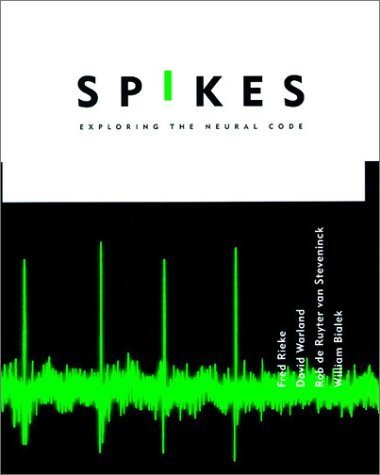Artículos relacionados a Spikes: Exploring the Neural Code (Computational Neuroscienc...

Sinopsis
Our perception of the world is driven by input from the sensory nerves. This input arrives encoded as sequences of identical spikes. Much of neural computation involves processing these spike trains. What does it mean to say that a certain set of spikes is the right answer to a computational problem? In what sense does a spike train convey information about the sensory world? Spikes begins by providing precise formulations of these and related questions about the representation of sensory signals in neural spike trains. The answers to these questions are then pursued in experiments on sensory neurons.
The authors invite the reader to play the role of a hypothetical observer inside the brain who makes decisions based on the incoming spike trains. Rather than asking how a neuron responds to a given stimulus, the authors ask how the brain could make inferences about an unknown stimulus from a given neural response. The flavor of some problems faced by the organism is captured by analyzing the way in which the observer can make a running reconstruction of the sensory stimulus as it evolves in time. These ideas are illustrated by examples from experiments on several biological systems.
Intended for neurobiologists with an interest in mathematical analysis of neural data as well as the growing number of physicists and mathematicians interested in information processing by "real" nervous systems, Spikes provides a self-contained review of relevant concepts in information theory and statistical decision theory. A quantitative framework is used to pose precise questions about the structure of the neural code. These questions in turn influence both the design and analysis of experiments on sensory neurons.
"Sinopsis" puede pertenecer a otra edición de este libro.
Críticas
""Spikes" is a really wonderful book. The particular theory about how the brain works that informs the presentation, and thus determines how neural coding is to be described, is clearly thought through and the arguments are attractively and intelligently presented."--Charles F. Stevens, The Salk Institute
Reseña del editor
Our perception of the world is driven by sensory input which is sent to our brains through sequences of spikes carried by sensory neurons, an incoming/outgoing "language of the brain". This book explores the way in which the nervous system represents or encodes these sensory signals, asking in particular whether a linguistic analogy makes sense, whether as in language, there are notions of context that can influence the meaning of the individual words, and whether these questions can be given precise formulations in the design and analysis of experiments on neurons. The authors invite the reader to play the role of a homunculus, a hypothetical observer inside the brain who makes decisions based on the incoming spike trains. This perspective differs from the more traditional ones in two respects: rather than asking how a neuron responds to a given stimulus, the authors ask how the brain could make inferences about an unknown stimulus from a given neural response. The flavour of some problems faced by the organism is captured by analyzing the way in which the observer can make a running reconstruction of the sensory stimulus as it evolves in time. These ideas are illustrated by examples from experiments on many biological systems. Intended for neurobiologists with an interest in mathematical analysis of neural data as well as the growing number of physicists and mathematicians interested in information processing by "real" nervous systems, "Spikes" provides a self-contained review of relevant concepts in information theory and statistical decision theory. A quantitative framework is used to pose precise questions about the structure of the neural code and these questions in turn influence both the design of experiments and the data analysis.
"Sobre este título" puede pertenecer a otra edición de este libro.
EUR 26,00 gastos de envío desde Holanda a Estados Unidos de America
Destinos, gastos y plazos de envíoComprar nuevo
Ver este artículoEUR 3,65 gastos de envío en Estados Unidos de America
Destinos, gastos y plazos de envíoResultados de la búsqueda para Spikes: Exploring the Neural Code (Computational Neuroscienc...
Spikes. Exploring the Neural Code [Computational Neuroscience]
Librería: Pallas Books Antiquarian Booksellers, Leiden, Holanda
cloth, dustjacket, 4to xvii+395 pp., ills. our perception of the world is driven by input from the sensory nerves; this input arrives encoded as sequences of identical spikes; neural computation involves processing these spike trains; very good condition (unused). Nº de ref. del artículo: 33284
Cantidad disponible: 1 disponibles
Spikes: Exploring the Neural Code (Computational Neuroscience)
Librería: BooksRun, Philadelphia, PA, Estados Unidos de America
Hardcover. Condición: Good. With dust jacket. It's a preowned item in good condition and includes all the pages. It may have some general signs of wear and tear, such as markings, highlighting, slight damage to the cover, minimal wear to the binding, etc., but they will not affect the overall reading experience. Nº de ref. del artículo: 0262181746-11-1-29
Cantidad disponible: 1 disponibles
Spikes: Exploring the Neural Code (Computational Neuroscience)
Librería: Toscana Books, AUSTIN, TX, Estados Unidos de America
Hardcover. Condición: new. Excellent Condition.Excels in customer satisfaction, prompt replies, and quality checks. Nº de ref. del artículo: Scanned0262181746
Cantidad disponible: 1 disponibles

